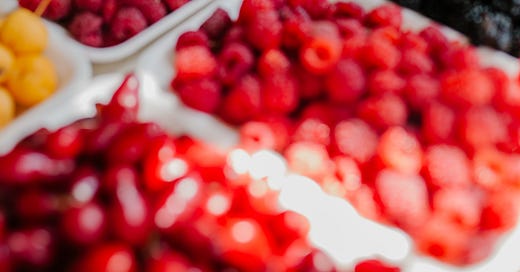"Why Back Pain Can Get Reduced by a Colorful Diet"
Smart decisions about diet can significantly reduce unwanted excessive inflammations.
Are you wondering how to avoid excessive inflammation which causes you back pain, or aggrevates your existing back pain ?
Instead of taking chemical anti-inflammatory pills that might get you unwanted side effects, consider using natural methods to prevent and recover from health issues. But check with your physician first if it is okay to just rely on mild natural methods as some inflammations are serious and need strong antidotes. Don´t just skip the meds without consulting your doctor first, please. Anway, it will only be good to improve to your nutrition habits when it comes to back pain management.
Numerous studies have shown that many plants have the ability to fight against excessive inflammation, which is a major cause of pain, including those nagging backaches (see my long list of references at the end of the article if you want to dive deeper).
Okay, let´s get some simple basics cleared. Inflammation is like a two-sided coin: it's good for fighting infections and healing, but too much of it can make you sick. There are lots of reasons for this chronic inflammation, and one biggie is eating unhealthy food, which can mess with your health, including your spine.
You can do something very simple about it by eating these anti-inflammatory foods:
Berries: These little guys bring color into your life.
Turmeric (or curcuma): The golden ticket to a healthier you.
Spirulina: Sounds alien, but it's packed with nutrients.
Fermented soy foods: A friend to your gut and your well-being.
Leafy greens (kale, spinach...): Popeye knew his stuff, right?
Broccoli: Your mom was onto something with this green goodness.
Red beetroot: It's more than just a vibrant color.
Virgin olive oil: A Mediterranean secret for your health.
Cinnamon: The tasty sprinkle that does wonders.
Take it easy and make these foods a regular part of your diet in the right amounts. They help boost your natural killer cells (NK cells), which are like your body's security team, protecting you from nasty stuff. They also help you stay away from common problems like heart attacks, diabetes, obesity, cancer, and strokes. Plus, they give your whole body a boost, making you look and feel better, with healthier skin and hair.
Don't be afraid to experiment with these healthy foods to find what you like best. It's not just about being healthy; it's about feeling great inside and out. Eating right is a key part of staying healthy, including taking care of your spine. So, enjoy your journey to better health! 🥗🍇🍛
References:
Bagheri R, Alsadi N, Matar C, Sharifzad F, Shahbazi R, Yasavoli-Sharahi H. Anti-Inflammatory and Immunomodulatory Properties of Fermented Plant Foods. Nutrients. 2021 Apr 30;13(5):1516. doi: 10.3390/nu13051516. PMID: 33946303; PMCID: PMC8147091.
Chen CO, Palmery M, Peluso I, Villano Valencia D. Antioxidant, Anti-Inflammatory, and Microbial-Modulating Activities of Nutraceuticals and Functional Foods 2019. Oxid Med Cell Longev. 2020 Apr 2;2020:6981542. doi: 10.1155/2020/6981542. PMID: 32318241; PMCID: PMC7154974.
Clifford T, Howatson G, Stevenson EJ, West DJ. The potential benefits of red beetroot supplementation in health and disease. Nutrients. 2015 Apr 14;7(4):2801-22. doi: 10.3390/nu7042801. PMID: 25875121; PMCID: PMC4425174.
Das D, Kalita J, Manna P, Sarkar S, Wann S Borsingh. Current perspectives on the anti-inflammatory potential of fermented soy foods. Food Res Int. 2022 Feb;152:110922. doi: 10.1016/j.foodres.2021.110922. Epub 2021 Dec 22. PMID: 35181093.
Freder J, Armbruester N, Gruenwald J. Cinnamon and health. Crit Rev Food Sci Nutr. 2010 Oct;50(9):822-34. doi: 10.1080/10408390902773052. PMID: 20924865.
Ghasemian M, Owlia MB, Owlia S. Review of Anti-Inflammatory Herbal Medicines. Adv Pharmacol Sci. 2016;2016:9130979. doi: 10.1155/2016/9130979. Epub 2016 May 10. PMID: 27247570; PMCID: PMC4877453.
Joseph SV, Burton-Freeman BM, Edirisinghe I. Berries: anti-inflammatory effects in humans. J Agric Food Chem. 2014 May 7;62(18):3886-903. doi: 10.1021/jf4044056. Epub 2014 Mar 17.PMID: 24512603.
Lucas L, Keast R, Russell A. Molecular mechanisms of inflammation. Anti-inflammatory benefits of virgin olive oil and the phenolic compound oleocanthal. Curr Pharm Des. 2011;17(8):754-68. doi: 10.2174/138161211795428911. PMID: 21443487.
Maleki SJ, Cabanillas B, Crespo JF. Anti-inflammatory effects of flavonoids. Food Chem. 2019 Nov 30;299:125124. doi: 10.1016/j.foodchem.2019.125124. Epub 2019 Jul 3. PMID: 31288163.
Peluso I, Villano Valencia D, Chen CO, Palmery M. Antioxidant, Anti-Inflammatory, and Microbial-Modulating Activities of Nutraceuticals and Functional Foods 2019. Oxid Med Cell Longev. 2020 Apr 2;2020:6981542. doi: 10.1155/2020/6981542. PMID: 32318241; PMCID: PMC7154974.
Prasad AS. Zinc: an antioxidant and anti-inflammatory agent: role of zinc in degenerative disorders of aging. J Trace Elem Med Biol. 2014 Oct;28(4):364-71. doi: 10.1016/j.jtemb.2014.07.019. Epub 2014 Aug 12. PMID: 25200490.
Shahbazi R, Sharifzad F, Bagheri R, Alsadi N, Matar C, Yasavoli-Sharahi H. Anti-Inflammatory and Immunomodulatory Properties of Fermented Plant Foods. Nutrients. 2021 Apr 30;13(5):1516. doi: 10.3390/nu13051516. PMID: 33946303; PMCID: PMC8147091.
Vahid F, Rahmani D. Can an anti-inflammatory diet be effective in preventing or treating viral respiratory diseases? A systematic narrative review. Clin Nutr ESPEN. 2021 Jun;43:9-15. doi: 10.1016/j.clnesp.2021.04.009. Epub 2021 Apr 24. PMID: 34024569.
Wu Q, Kuča K, Liu L, Miron A, Wan D, Zhu F. Anti-inflammatory effects of phytochemicals from fruits, vegetables, and food legumes: A review. Crit Rev Food Sci Nutr. 2018 May 24;58(8):1260-1270. doi: 10.1080/10408398.2016.1251390. Epub 2017 Jun 12. PMID: 28605204.
Yatoo MI, Chakraborty S, Dhama K, Gopalakrishnan A, Iqbal HMN, Parray OR, Saxena A, Tiwari R. Anti-Inflammatory Drugs and Herbs with Special Emphasis on Herbal Medicines for Countering Inflammatory Diseases and Disorders - A Review. Recent Pat Inflamm Allergy Drug Discov. 2018;12(1):39-58. doi: 10.2174/1872213X12666180115153635.



